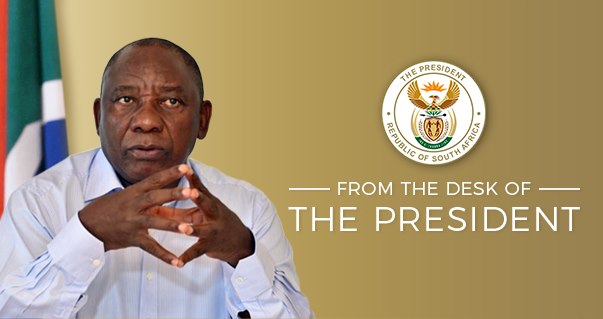FROM THE DESK OF THE PRESIDENT - 24 APRIL 2023

WE MUST TACKLE THE ENERGY CRISIS AND CLIMATE CHANGE AT THE SAME TIME
Dear Fellow South African,
The country is faced with both an electricity crisis and a climate crisis, which we must tackle together. As we intensify our efforts to address the electricity shortfall, we remain committed to reduce our carbon emissions through a just transition.
Intensive work is underway to reduce load shedding by improving the performance of Eskom’s power stations. This includes returning units at the Kusile and Medupi power stations to service on schedule, which will together add over 3,500 MW back to the grid. It also includes improving the quality of coal supplied to power stations and ensuring that appropriate skills, adequate funding and effective planning are put in place for maintenance.
We are making real progress in adding new generation capacity to the grid, buying power from neighbouring countries, fast-tracking new wind, solar, battery storage and gas projects. We have previously said that we have a deficit of some 6,000 MW, which we are working to close through all these efforts.
We are seeing a massive surge of private investment in electricity generation as a result of reforms we have embarked upon. These reforms mean that private companies can invest in generation projects of any size and feed their power into the grid.
While these initiatives give us confidence that we will end load shedding, they will take time to show results.
Eskom is undertaking necessary maintenance now to ensure that planned outages can be limited during winter, when demand is expected to increase. As we enter the winter months, when our consumption of electricity rises, we will need to manage our use of electricity. One of the ways in which every South African can contribute to reduce load shedding is by switching off at peak times the home appliances that use a lot of electricity, such as geysers. There are simple energy saving solutions like geyser timers or geyser blankets that we can use.
One of the issues widely discussed in light of the current electricity shortfall is the pace at which older coal-fired power stations that are coming to the end of their lives will be decommissioned.
South Africa has committed to reduce its carbon emissions by 2030 to within a target range which, at its upper level, is compatible with limiting global temperature increase to 1.5ºC.
We remain committed to achieving this target. We need to do this to prevent the worst effects of climate change, including droughts, floods and other disasters. We also need to protect jobs in sectors of our economy that have to decarbonise to remain globally competitive. However, the manner in which these commitments are achieved must not compromise energy security or the immediate priority of reducing load shedding.
In some cases, it may be necessary to re-examine the timeframe and the process of decommissioning or mothballing of coal-fired power stations temporarily to address our electricity supply shortfall. Few would argue that we should close down power stations even as we experience load shedding. A number of countries in Europe that had decommissioned or mothballed their fossil fuelled power stations are recommissioning them to address the current energy shortage as a result of the conflict between Ukraine and Russia.
The process of re-examining our timeframes is not a reversal of our position on the just energy transition. Other countries have had to do the same in recent years without deviating from their long-term shift to renewable energy sources.
Any decision on decommissioning will be informed by a detailed technical assessment of the feasibility of continuing to operate older plants. It will also be informed by the timeframe in which we can expect new capacity from other energy sources and the impact on our decarbonisation trajectory.
The health and environmental impact of emissions from coal-fired power stations also needs to be considered. In a meeting last week of the Presidential Climate Commission, it was pointed out that the transition to clean energy sources will prevent more than 400,000 avoidable deaths attributable to air pollution by 2050.
With so much at stake, we must ensure that our decisions are taken carefully and informed by science and evidence. Our position is clear and principled: it is possible for us to prioritise our immediate energy needs without jeopardising our climate commitments, and we are determined to do so. In fact, we must accelerate the pace of investment in new renewable electricity generation as an important part of the plan to overcome loadshedding.
How we respond to the energy crisis will determine the future of our country and the growth of our economy. In addition to ending load shedding, the Energy Action Plan will act as a springboard to a just energy transition, boosting the rollout of renewable energy sources, mobilising hundreds of billions of Rand in investment and creating new jobs in sectors from electric vehicles to solar installation.
We must be able to look back on this crisis as a crucial turning point for South Africa – as a moment where we not only worked together to overcome a national challenge, but laid the foundation for a better future.
With best regards,



